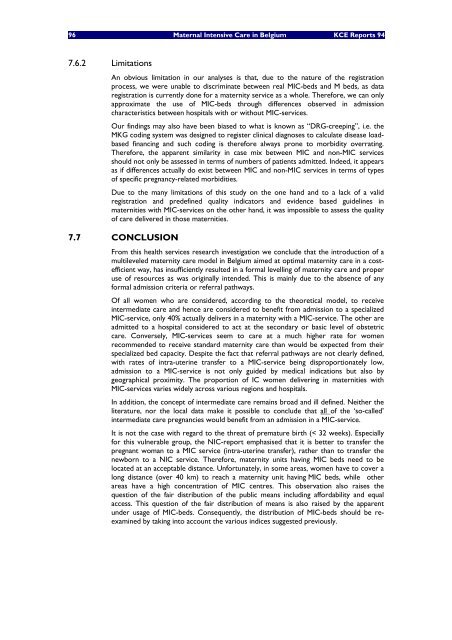Soins maternels intensifs (Maternal Intensive Care) en Belgique - KCE
Soins maternels intensifs (Maternal Intensive Care) en Belgique - KCE
Soins maternels intensifs (Maternal Intensive Care) en Belgique - KCE
Create successful ePaper yourself
Turn your PDF publications into a flip-book with our unique Google optimized e-Paper software.
96 <strong>Maternal</strong> <strong>Int<strong>en</strong>sive</strong> <strong>Care</strong> in Belgium <strong>KCE</strong> Reports 94<br />
7.6.2 Limitations<br />
An obvious limitation in our analyses is that, due to the nature of the registration<br />
process, we were unable to discriminate betwe<strong>en</strong> real MIC-beds and M beds, as data<br />
registration is curr<strong>en</strong>tly done for a maternity service as a whole. Therefore, we can only<br />
approximate the use of MIC-beds through differ<strong>en</strong>ces observed in admission<br />
characteristics betwe<strong>en</strong> hospitals with or without MIC-services.<br />
Our findings may also have be<strong>en</strong> biased to what is known as “DRG-creeping”, i.e. the<br />
MKG coding system was designed to register clinical diagnoses to calculate disease loadbased<br />
financing and such coding is therefore always prone to morbidity overrating.<br />
Therefore, the appar<strong>en</strong>t similarity in case mix betwe<strong>en</strong> MIC and non-MIC services<br />
should not only be assessed in terms of numbers of pati<strong>en</strong>ts admitted. Indeed, it appears<br />
as if differ<strong>en</strong>ces actually do exist betwe<strong>en</strong> MIC and non-MIC services in terms of types<br />
of specific pregnancy-related morbidities.<br />
Due to the many limitations of this study on the one hand and to a lack of a valid<br />
registration and predefined quality indicators and evid<strong>en</strong>ce based guidelines in<br />
maternities with MIC-services on the other hand, it was impossible to assess the quality<br />
of care delivered in those maternities.<br />
7.7 CONCLUSION<br />
From this health services research investigation we conclude that the introduction of a<br />
multileveled maternity care model in Belgium aimed at optimal maternity care in a costeffici<strong>en</strong>t<br />
way, has insuffici<strong>en</strong>tly resulted in a formal levelling of maternity care and proper<br />
use of resources as was originally int<strong>en</strong>ded. This is mainly due to the abs<strong>en</strong>ce of any<br />
formal admission criteria or referral pathways.<br />
Of all wom<strong>en</strong> who are considered, according to the theoretical model, to receive<br />
intermediate care and h<strong>en</strong>ce are considered to b<strong>en</strong>efit from admission to a specialized<br />
MIC-service, only 40% actually delivers in a maternity with a MIC-service. The other are<br />
admitted to a hospital considered to act at the secondary or basic level of obstetric<br />
care. Conversely, MIC-services seem to care at a much higher rate for wom<strong>en</strong><br />
recomm<strong>en</strong>ded to receive standard maternity care than would be expected from their<br />
specialized bed capacity. Despite the fact that referral pathways are not clearly defined,<br />
with rates of intra-uterine transfer to a MIC-service being disproportionately low,<br />
admission to a MIC-service is not only guided by medical indications but also by<br />
geographical proximity. The proportion of IC wom<strong>en</strong> delivering in maternities with<br />
MIC-services varies widely across various regions and hospitals.<br />
In addition, the concept of intermediate care remains broad and ill defined. Neither the<br />
literature, nor the local data make it possible to conclude that all of the ‘so-called’<br />
intermediate care pregnancies would b<strong>en</strong>efit from an admission in a MIC-service.<br />
It is not the case with regard to the threat of premature birth (< 32 weeks). Especially<br />
for this vulnerable group, the NIC-report emphasised that it is better to transfer the<br />
pregnant woman to a MIC service (intra-uterine transfer), rather than to transfer the<br />
newborn to a NIC service. Therefore, maternity units having MIC beds need to be<br />
located at an acceptable distance. Unfortunately, in some areas, wom<strong>en</strong> have to cover a<br />
long distance (over 40 km) to reach a maternity unit having MIC beds, while other<br />
areas have a high conc<strong>en</strong>tration of MIC c<strong>en</strong>tres. This observation also raises the<br />
question of the fair distribution of the public means including affordability and equal<br />
access. This question of the fair distribution of means is also raised by the appar<strong>en</strong>t<br />
under usage of MIC-beds. Consequ<strong>en</strong>tly, the distribution of MIC-beds should be reexamined<br />
by taking into account the various indices suggested previously.

















